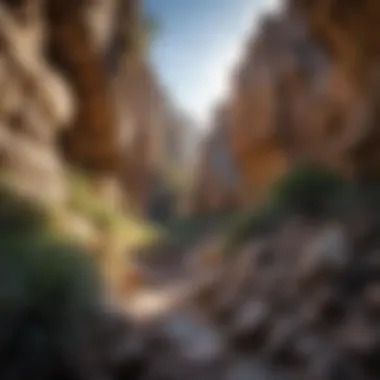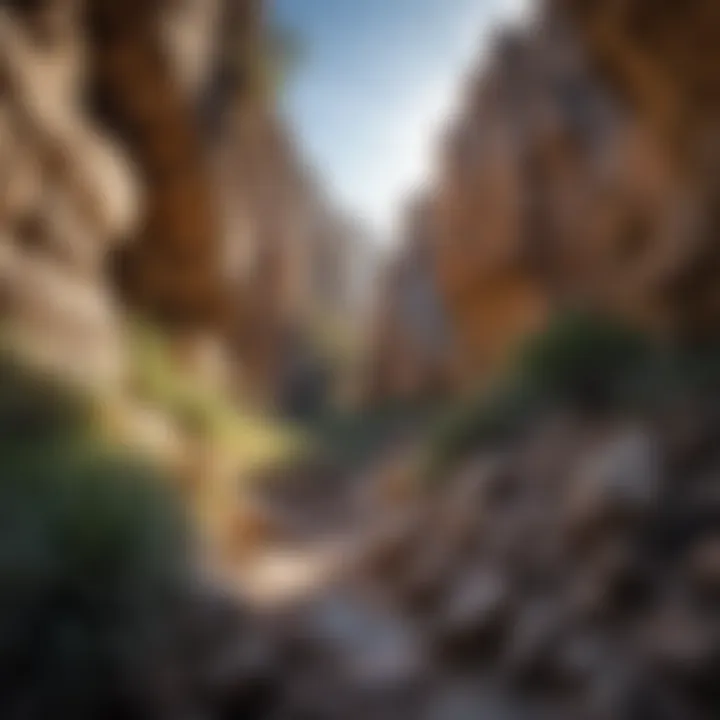Exploring Ventana Canyon: Tucson's Ecological Gem


Intro
Ventana Canyon is not merely a geographical location in Tucson, Arizona. It is a symbiotic ecosystem of immense ecological significance. As a woodland area, it embodies both the beauty of nature and the complexity of biological diversity. This comprehensive look will unravel various aspects, such as the unique flora and fauna that call this canyon home. We will also explore the geological features that shape its identity and the rich cultural history that enhances its charm.
In understanding this area, we can develop greater awareness of woodland ecosystems’ importance. The flora and fauna play critical roles in not only maintaining biodiversity but also in regulating the environment. By studying Ventana Canyon closely, we gain insight into sustainable practices which can be adopted in conservation efforts. This understanding is particularly relevant for forestry professionals and academics who aspire to foster a balance between human interaction and natural preservation.
Through careful analysis and observation, we will convey the ecological significance of this region. The focus lies in fostering a deep appreciation of the natural world, with an aim to promote sustainable adventures for visitors. Armed with knowledge about the local ecosystems, those who wander through Ventana Canyon can become advocates for its preservation. Ultimately, this article seeks to inspire curiosity, respect, and responsibility toward Ventana Canyon’s remarkable natural heritage.
Foreword to Ventana Canyon
Ventana Canyon is not merely a geographical location; it is a vital ecological area teeming with biodiversity and rich in cultural history. This section aims to shed light on why Ventana Canyon deserves attention. Understanding its geographical and historical backdrop offers insights into its ecological significance.
Geographical Overview
Ventana Canyon is situated in Tucson, Arizona, carved into the eastern foothills of the Santa Catalina Mountains. This area is part of the larger Coronado National Forest, characterized by rugged terrain, steep canyons, and diverse ecosystems. The elevation ranges from about 2,800 to over 5,000 feet, creating various microclimates that support a wide range of flora and fauna. The canyon itself stretches approximately six miles, offering numerous trails and scenic viewpoints.
The prominent feature of Ventana Canyon is its unique geology, formed by volcanic rocks and sedimentary layers. These rock formations provide a glimpse into the earth's history and influence the biodiversity in the region. The climate in Ventana Canyon is primarily arid, with hot summers and mild winters. However, the presence of the canyon microclimates allows for more temperate conditions in certain areas, fostering a rich habitat for numerous species.
Historical Significance
The history of Ventana Canyon is as layered as its geological structure. For centuries, this area has been significant to various Native American tribes, particularly the Tohono O’odham and the Pascua Yaqui. Their cultural practices and spiritual beliefs are intertwined with the land, emphasizing a profound connection to nature. Historical artifacts and petroglyphs found within the canyon provide evidence of human activity dating back thousands of years.
In the late 19th and early 20th centuries, Ventana Canyon gained popularity among early settlers and explorers. It became a refuge for those seeking solace in the natural beauty and rugged terrain. As Tucson developed, the canyon's recreational potential was recognized, leading to its designation as a protected area. Today, Ventana Canyon stands as a testament to both its natural and cultural heritage, making it an essential focal point in the study of Southwestern ecology and history.
"Understanding the geographical and historical context of Ventana Canyon allows us to appreciate its complex ecosystems fully and the role it plays in Southern Arizona's ecology."
In summary, grasping the geographical overview and historical significance is crucial to appreciating Ventana Canyon's unique character and ecological importance. The intertwining of culture and nature here highlights the necessity of stewardship for future generations.
Ecological Characteristics
Ventana Canyon embodies an essential part of Tucson's natural ecosystem. Understanding its ecological characteristics is vital not just for appreciating its beauty but also for recognizing its role in promoting biodiversity and sustainability. This section emphasizes the unique elements of Ventana Canyon's flora and fauna, illustrating the interconnectedness of these species with their environment. The analysis of ecological features aids in developing strategies for conservation, enabling visitors and locals alike to engage responsibly with this precious resource.
Flora of Ventana Canyon
The flora of Ventana Canyon is diverse and reflects a variety of habitats within the region. The canyon supports a mix of desert species, woodlands, and riparian plants. Notable plants include the iconic saguaro cactus and various species of agave. The interplay of elevation and geography creates microhabitats that allow distinct plant communities to thrive.
- Saguaro Cactus (Carnegiea gigantea): This towering plant is symbolic of the Sonoran Desert and supports numerous wildlife species.
- Creosote Bush (Larrea tridentata): Known for its resilience, it plays a key role in the ecosystem's functionality.
- Cottonwood Trees (Populus fremontii): Often found near water sources, these trees provide shade and habitat.
The seasonal changes significantly impact the vegetation; for example, summer monsoons trigger a burst of growth and blooming periods. Recognizing the timing of these changes equips visitors with knowledge to witness the canyon's dynamic landscape and its ecological rhythms.
Fauna of Ventana Canyon
Ventana Canyon is home to a variety of wildlife, contributing to the ecological richness of the area. Animals adapted to the diverse habitats include mammals, birds, reptiles, and invertebrates.
- Desert Cottontail (Sylvilagus audubonii): A common sight, these rabbits play an important role as prey for larger predators.
- Coyote (Canis latrans): At the top of the food chain, coyotes help maintain the balance of the ecosystem.
- Gila Monster (Heloderma suspectum): This venomous lizard showcases the evolutionary adaptations of reptiles in arid conditions.
Birdwatching opportunities abound in Ventana Canyon, with species such as the Gambel's quail and the cactus wren making their home in this region. Understanding the interactions among these species highlights the importance of habitat preservation and the need for continued ecological education.
Biodiversity and Conservation
The biodiversity in Ventana Canyon reinforces its significance as an ecological treasure. The interactions among different species and their habitats create a complex web of life essential for ecosystem stability. This region is not just a reservoir of species; it also offers insights into ecological processes and evolution.
Biodiversity brings numerous benefits, including:


- Ecosystem Services: Clean air, water filtration, and pollination are crucial components of a healthy environment.
- Resilience to Change: Diverse ecosystems are better equipped to withstand shocks such as climate change and invasive species.
- Cultural Value: Indigenous history and knowledge about this area emphasize the need to respect and maintain these natural systems.
Conservation efforts must focus on mitigating human impact and fostering sustainable practices. Engaging local communities and stakeholders is crucial for effective stewardship. As awareness grows, so too does the potential for ecotourism in the area, making it imperative to balance recreational use with conservation goals.
"Protecting biodiversity is essential for maintaining the overall health of our planet and ensuring that future generations can enjoy the richness of our natural world."
In summary, understanding the ecological characteristics of Ventana Canyon is paramount. The flora and fauna, along with ongoing conservation efforts, highlight the need for a collective responsibility towards preserving this unique environment.
Geological Features
Geological features play a significant role in understanding the natural landscape of Ventana Canyon. The diverse rock formations and water features found in the canyon contribute not only to its aesthetic value but also to its ecological dynamics. These geological characteristics create unique habitats, support varied plant and animal life, and influence water availability in the area. This exploration into geological features will provide insights into their importance and relevance in the context of Ventana Canyon's ecology.
Rock Formations
The rock formations in Ventana Canyon are striking and varied, offering a glimpse into the geological history of the region. Composed mainly of limestone and granite, these rocks have been shaped over eons by natural forces including wind and water erosion. Some notable formations include the towering cliffs, which rise dramatically and create a stunning backdrop for the canyon's surroundings.
These rock formations serve multiple ecological purposes. They provide unique microhabitats for various species, including plants that thrive in rocky outcrops. Birds of prey can often be seen nesting in crevices, taking advantage of the height for hunting and protection. The geological structure also influences soil composition at the base, which in turn affects which species can grow there. The interplay of geology and biology is crucial for maintaining biodiversity in the canyon.
Water Features
Water features in Ventana Canyon are integral to its ecological makeup. Seasonal streams and ponds not only enhance the beauty of the landscape but also support diverse life forms. The availability of water plays a critical role in shaping the habitats within the canyon.
There are several important aspects regarding water features to consider:
- Habitat for Wildlife: Many animals rely on water sources for drinking and breeding. A variety of birds, amphibians, and mammals can be found in proximity to these features.
- Plant Life: Riparian zones near water courses are often lush with vegetation, providing cover and sustenance for various species. This area can be rich in plant diversity, which adds to the overall ecological health of Ventana Canyon.
- Erosion and Sedimentation: Water flow can sculpt the canyon landscape, creating new rock formations and influencing sediment distribution. This process can lead to shifts in biodiversity as new environments are formed.
"The interplay between rock and water in Ventana Canyon illustrates the delicate balance within ecosystems, showcasing the resilience and adaptability of nature."
In closing, the geological features of Ventana Canyon are essential to understanding its ecological significance. By studying the rock formations and water features, one gains a fundamental appreciation of how these elements interact to support the diverse life that thrives in this remarkable landscape.
Recreational Opportunities
In Ventana Canyon, the recreational prospects are varied and appealing. Engaging with this natural environment provides not only physical enjoyment but also mental rejuvenation. Each opportunity presents a unique lens through which visitors can appreciate the ecosystem. Understanding these options is essential for effectively planning a visit.
Hiking Trails
Ventana Canyon boasts a network of hiking trails suited for various skill levels. These trails allow visitors to explore the region’s diverse habitats closely. The Ventana Canyon Trail, for instance, stretches about 4.6 miles with moderate difficulty. Hikers often enjoy rocky landscapes and sweeping views of the Sonoran Desert.
The trails are well-marked, which aids navigation. It is advisable to take along sufficient water, especially during warmer months. The balance of challenge and beauty rewards hikers with numerous scenic vistas and opportunities to witness unique flora native to the area.
Wildlife Observation
Wildlife observation is a key aspect of Ventana Canyon's appeal. The region is home to a variety of species. This includes birds, mammals, and reptiles, which can often be seen in their natural habitat. Locations such as the Windy Point offer ideal vantage points for spotting wildlife.
Visitors should engage in quiet observation. This practice enhances the chance of sightings. Binoculars provide extra detail when observing birds, such as the Canyon Towhee or Black-throated Sparrows. Understanding animal behaviors and their habitats enriches the experience, making wildlife observation both educational and rewarding.
Photographic Pursuits
For photography enthusiasts, Ventana Canyon presents countless opportunities. The interplay of light and shadow against rugged rock formations creates striking visuals. Sunrise and sunset are particularly magical times to capture stunning landscapes.
Certain areas, like the Coyote Pause, provide excellent perspectives for landscape photography. It is wise to bring a tripod for stability and clarity in low-light conditions. Different terrains, plants, and wildlife offer varied possibilities, which cater to different styles and subjects in photography. Image capturing is not just an activity but a medium to share the beauty of the canyon with a broader audience.
Engaging in these recreational opportunities enhances appreciation for Ventana Canyon's unique qualities and the responsibilities associated with its conservation.


Cultural Aspects
Cultural aspects of Ventana Canyon play a crucial role in understanding both its historical context and its present significance. The rich history intertwined with the natural environment adds layers of meaning to this ecological gem. Recognizing these cultural elements enhances the visitor experience and supports conservation efforts through increased appreciation of the area.
Indigenous History
The landscapes of Ventana Canyon have been shaped not only by natural forces but also by the people who have inhabited the region for centuries. Indigenous tribes, particularly the Tohono O’odham and the Apache, have deep connections with the land. They relied on its resources for sustenance, weaving their traditions and beliefs into the fabric of the ecosystem.
Understanding this history offers valuable insights into how ancient practices and knowledge contribute to modern conservation approaches. The use of native plants for culinary, medicinal, and ceremonial purposes illustrates a sophisticated relationship with the environment. This knowledge base, passed down through generations, can inform contemporary ecological practices and promote biodiversity.
Modern Day Significance
In today's context, the cultural significance of Ventana Canyon extends beyond its historical foundations. It has become a place for education and reflection on environmental stewardship. Local organizations and educational programs often emphasize the importance of preserving both the ecology and the cultural narratives associated with the area. Visitors and community members are encouraged to engage with Indigenous leaders and learn about their sustainable practices.
Moreover, the canyon serves as a living classroom for those interested in ecology, anthropology, and conservation. Workshops and guided tours highlight Indigenous perspectives and articulate visions for sustainable coexistence with nature.
It is through understanding and respecting Indigenous histories that we can appreciate the intricate balance of cultural and ecological health in Ventana Canyon.
By integrating cultural awareness into conservation strategies, we can foster a deeper commitment to protecting this ecological treasure for future generations. The legacy of the land and its peoples is integral not only to its past but also to its future.
Sustainability and Stewardship
Sustainability and stewardship are crucial components in the discourse about Ventana Canyon. As an ecological gem, this area showcases an intricate web of interdependent species and habitats. Over time, increased recreation, urban development, and climate change have posed threats to its ecosystems. A thoughtful approach to sustainability helps minimize these impacts while enhancing the natural beauty of the canyon.
The benefits of implementing sustainable practices are manifold. They include preserving biodiversity, maintaining ecosystem health, and promoting resilience against various environmental pressures. Conversations surrounding sustainability also encourage a proactive stance among the community and visitors.
Sustainable Practices
Sustainable practices in Ventana Canyon encompass a range of strategies aimed at protecting its delicate ecosystems. One core principle is responsible recreation. Visitors are encouraged to stay on designated trails to prevent soil erosion and damage to native vegetation. Moreover, the use of low-impact camping techniques can greatly reduce human footprints in sensitive areas.
Aside from recreation, wildlife protection plays an essential role. Adopting measures that reverse human disturbances contributes to restoring balance in the ecosystem. Monitoring invasive species, for example, can ensure that native populations thrive without undue competition.
Another aspect of sustainability involves education. Workshops and information sessions about the local ecology can raise awareness of essential sustainable practices. Simple actions, such as picking up trash and minimizing noise, accumulate to foster a culture of respect for nature.
Community Involvement
Community involvement is integral to the stewardship of Ventana Canyon. Local organizations often spearhead initiatives that unite residents and visitors alike in conservation efforts. Active participation in clean-up drives or educational programs fosters a sense of ownership over the natural environment.
Collaborative efforts with organizations like the Sierra Club can amplify the impact of these endeavors. Through volunteer opportunities, individuals gain hands-on experience in conserving the ecology of the canyon. Together, the community can advocate for policies and funding that support sustainable initiatives.
"Sustainable practices are not only crucial for the environment but also for the communities that cherish these natural spaces."
Engagement, awareness, and involvement transform passive visitors into active stewards. In fostering this culture, we ensure that Ventana Canyon remains a flourishing ecological wonder.
Best Practices for Visitors
When visiting a natural area such as Ventana Canyon, understanding best practices is essential. These guidelines help protect the environment while ensuring a safe and enjoyable experience for everyone. Visitors play a crucial role in preserving the ecological integrity of the canyon. Therefore, awareness of responsible behavior is paramount.
Planning Your Visit
Effective preparation can elevate the quality of your experience at Ventana Canyon. Start by considering the weather and the season. The temperatures in Tucson may vary greatly; thus, you need to dress accordingly. Wearing layers allows adaptation to changing conditions.
Consider your mode of transportation. Many trails may require a reliable vehicle or specific parking options. Always check for any necessary permits, as certain areas may have restrictions.


Furthermore, familiarize yourself with trail maps and guidelines from local organizations. Websites like Wikipedia and Britannica provide helpful background information. This knowledge enhances appreciation and understanding of the natural surroundings you will encounter.
Be mindful of trail etiquette. Yielding to hikers coming uphill has become standard practice. This ensures a smoother transition along the trails and minimizes the risk of accidents.
Safety Guidelines
Safety is a primary concern when exploring natural landscapes. Being aware of potential hazards is essential to ensure a pleasurable outing. Here are key safety considerations:
- Hydration: Always bring enough water. Staying hydrated is essential, especially in the warm climate of Tucson. Dehydration can lead to severe health issues.
- Wildlife Awareness: Understand the local wildlife. This knowledge can help avoid confrontations. You may encounter rattlesnakes or other animals. Respect their space and maintain a safe distance.
- First Aid Kit: Carry a basic first aid kit. Injuries can happen anywhere, and being prepared allows for effective response.
Prioritizing safety enhances the overall experience in the wilderness. Respecting nature ensures that everyone can enjoy it safely.
- Sun Protection: Apply sunscreen regularly. The Arizona sun can be intense and prolonged exposure can cause harm.
Remember that cell phone reception can be limited in remote areas. Inform someone of your planned route and expected return time. This precaution increases your safety in case of emergencies.
Future Prospects for Ventana Canyon
The importance of understanding the future prospects for Ventana Canyon cannot be overstated. As a site rich in biodiversity and ecological significance, the considerations for its conservation and development are crucial. This section will explore key elements that influence its future, the benefits of these efforts, and thoughtful considerations that must be taken into account.
Conservation Efforts
Conservation efforts are essential for protecting the unique ecosystems within Ventana Canyon. These initiatives focus on several areas:
- Habitat Restoration: Programs are in place to restore native vegetation and improve habitat quality for local wildlife. This is particularly significant given the challenges posed by invasive species.
- Public Education: It is important to educate visitors and locals about the ecological value of the canyon. This includes information about flora and fauna and the impact of human activities.
- Collaborative Projects: Partnerships with local conservation organizations, government agencies, and schools can facilitate better resource management. Such collaborations can enhance the effectiveness of conservation strategies.
"Effective conservation requires community involvement and a commitment to preserving natural resources for future generations."
These efforts not only protect the biodiversity but also promote a sense of responsibility within the community towards their environment.
Ecotourism Potential
Ecotourism offers a promising avenue for the future of Ventana Canyon. By focusing on sustainable tourism practices, the canyon can draw visitors while minimizing environmental impact. Here are some key components of its ecotourism potential:
- Sustainable Amenities: Developing eco-friendly facilities that align with conservation efforts can enhance visitor experiences. This may include eco-lodges or guided nature tours utilizing local guides.
- Wildlife Observation: Creating platforms or designated areas for wildlife observation can foster appreciation for the local ecosystem. This can motivate visitors to engage more thoughtfully with nature.
- Educational Tours: Programs that blend education with exploration can elevate awareness of ecological issues and conservation strategies. This approach ensures that visitors leave with a deeper understanding of the challenges facing the canyon.
The future of Ventana Canyon hinges on a balance between promoting ecotourism and preserving its natural beauty. Encouraging responsible visitation can generate revenue that supports ongoing conservation initiatives while educating the public on the significance of protecting this ecological gem.
End
The importance of concluding an article about Ventana Canyon extends beyond mere summarization. It represents an opportunity to reinforce the key themes explored throughout the piece. By encapsulating the various elements discussed, readers will grasp the full scope of Ventana Canyon's ecological, cultural, and recreational significance. This section serves as a crucial reminder of the beauty and value that this ecological gem holds, not only for Tucson but for broader conservation efforts as well.
Summarizing Key Insights
Ventana Canyon emerges as an essential sanctuary, thriving with rich biodiversity and unique geological features. From its intricate flora, including various succulents and desert trees, to the diverse fauna that inhabits the area, such as native bird species, the canyon presents a microcosm of natural wonder.
Key insights include the following:
- Biodiversity: The canyon is home to numerous species, both flora and fauna, contributing to its ecological richness.
- Recreational Opportunities: The countless trails and wildlife observation points cater to those looking to engage with nature.
- Cultural History: The historical context enhances the value of the canyon, linking modern-day practices to ancient traditions.
- Conservation Efforts: Ongoing initiatives highlight the need for protective measures to preserve this natural resource for future generations.
In essence, Ventana Canyon acts as a living laboratory for ecological studies and offers a profound experience for outdoor enthusiasts.
Encouraging Land Stewardship
Encouraging land stewardship is vital for the continued preservation of Ventana Canyon. This can take multiple forms, from simple actions by individual visitors to larger initiatives involving local communities. Active participation is encouraged to ensure that the canyon's natural beauty is maintained and that its ecological integrity is not compromised.
Key considerations include:
- Responsible Recreation: Visitors should adhere to Leave No Trace principles. This is essential in minimizing human impact on delicate ecosystems.
- Community Engagement: Local involvement in conservation projects not only fosters a sense of ownership but also enhances educational opportunities regarding ecological practices.
- Awareness Raising: Informing peers and future visitors about the importance of maintaining natural habitats can create a more conscientious visitor base.
Ultimately, strengthening the bond between the community and Ventana Canyon can lead to a sustainable model for ecological stewardship. This means recognizing that every action taken contributes to the health and vitality of this ecological treasure. By fostering a culture of respect and responsibility, the legacy of Ventana Canyon can be preserved for generations to come.







